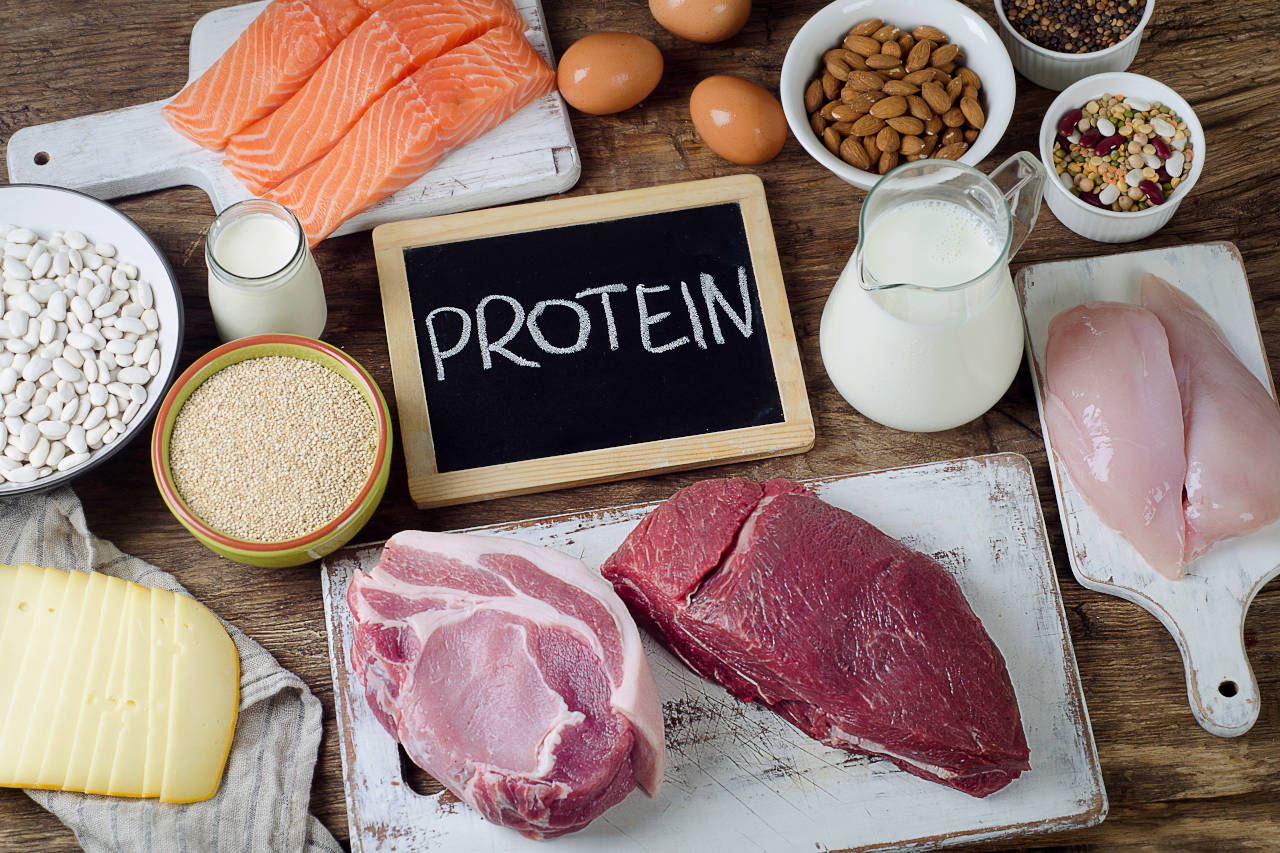Protein Intake Calculator
Enter your age, height, and weight to calculate the optimal daily protein intake.
On this page:
How Much Protein Do You Need?
Protein is the building block for muscle growth.[3] This macronutrient not only builds muscle, but also helps your body retain muscle mass as you age.
Optimal protein intake will be based on your specific goals and current weight. Protein intake is calculated as a percentage of your total caloric intake or may also be based on your weight.
When choosing your meals, you should look for lean protein sources, such as chicken, lean red meat like sirloin, or fish. In addition, if you want to get the most benefit from your protein intake, you should spread out your protein consumption throughout the day.

How To Calculate Protein Needs
The exact amount of protein you should aim to consume will depend on your specific goals and current weight. If you are engaged in high amounts of exercise, your protein needs may be higher than someone who is more sedentary.
This is because high levels of activity or intense workouts can rapidly break down muscle and require adequate protein intake for rebuilding.
In order to calculate your protein needs, you first need to determine your total calorie needs. This is based on the amount of energy you burn each day, or your total daily energy expenditure (TDEE).
Calculating your protein needs is dependent on three main components:
- Your basal metabolic rate (BMR): This is your resting metabolism, or basically the number of calories your body requires to function at complete rest.
- The thermic effect of food (TEF): This is defined as the energy cost of chewing, swallowing, digesting, absorbing and storing food. This number is influenced by the amount of calories you consume. That is, the more you eat, the higher your TEF will be. It is typically no more than 10% of your BMR.
- The thermic effect of physical activity (TEPA): This is the energy of activity (e.g., exercise, physical activity) and non-exercise activity thermogenesis (NEAT) together.
How to Calculate BMR
Everyone will have a different BMR since this is dependent on height, weight, age, and gender. There are a number of different formulas that have been developed over the years, but the most widely used today is the Mifflin-St Jeor formula.[4]
For Men:
BMR = (10 × weight in kg) + (6.25 × height in cm) – (5 × age in years) + 5
For Women:
BMR = (10 × weight in kg) + (6.25 × height in cm) – (5 × age in years) – 161
Since most people measure their weight in pounds, you first need to convert this to kilograms by dividing your weight by 2.2. If you are using inches for height, multiply this by 2.54 to determine your height in centimeters.
For example, a 35-year-old, 140-pound female who is 5’5″ (65 inches) tall would have a calculation that looks like this.
weight in kg = 140 ÷ 2.2 = 63.6 kg
height in cm = 65 × 2.54 = 165 cm
BMR = (10 × 63.6) + (6.25 × 165) – (5 × 35) – 161 = 1331 kcal
After you determine BMR, multiply this number by 1.1 to account for the thermic effect of food. In this case:
1331 × 1.1 = 1464 calories
How to Calculate TDEE
You then need to use this new number to calculate your total daily energy expenditure, or TDEE.
To determine your total daily calorie needs, factor in how much activity is done on a daily basis. Then multiply the BMR by the appropriate activity factor, as follows:[5]
| Level of Activity | Example | Activity Factor |
|---|---|---|
| Sedentary | Little to no exercise, such as a desk job with no additional physical activity | 1.2 |
| Lightly Active | Light exercise 1-2 days/week | 1.375 |
| Moderately Active | Moderate exercise 3-5 days/week | 1.55 |
| Very Active | Hard exercise 6-7 days/week | 1.725 |
| Extremely Active | Hard daily exercise and physical job or two times a day training | 1.9 |
By multiplying BMR by the activity factor, you now have an estimate of the total number of calories you should eat each day to maintain your current weight.
If you are trying to maintain your weight, you can simply use this number to determine your daily calorie needs. However, if you are looking to lose or gain weight, you first need to adjust this number based on weight goals.
In the above example, if this woman was moderately active, her TDEE would be:
TDEE = 1464 × 1.55 = 2269 kcal
If you want to lose weight, reduce your calorie intake by about 500 calories per day.[4] If your goal is to gain weight, you will need to increase your calories. Some suggest increasing calories by 5–15% or 400 to 500 calories per day.
If the same woman in the example wishes to lose weight, she would subtract 500 calories from her TDEE.
2269 – 500 calories = 1,769 calories per day
Therefore, in order to lose weight, she would want to consume about 1,770 calories per day. However, it is important to note that several other factors will affect weight loss, and this is just a starting point.
Now that you have determined your daily calorie needs, you can calculate your desired protein intake.
Two Methods to Calculate Protein Intake
There are two main ways to calculate your daily protein needs: By determining your protein intake based on a percentage of your daily calories or by using your body weight.
Method One: Calculate Macros
The foods you eat consist of three macronutrients, or macros as they are often called. These are protein, carbohydrates, and fat. Each of these macronutrients will make up a percentage of your total calories.
The amount of each macronutrient that you should include in your diet will depend on your current weight and fitness goals.
The 2015-2020 Dietary Guidelines for Americans recommend that the percentage of calories from protein intake should be between 10 and 35%, carbohydrates between 45 and 65%, and fats between 25 and 35%.[6] This is a fairly wide range, which is why you should base protein intake on your level of activity and dietary goals.
| Goal | Protein | Carbohydrate | Fat |
|---|---|---|---|
| General Fitness | 10-15% | 45-55% | 25-35% |
| Medium to High Intensity Fitness | 20-30% | 55-65% | 30% |
| Weight Loss | 25-30% | 45-50% | 20-25% |
By taking your daily caloric needs and multiplying them by the desired protein percentage, you will then have the number of calories you should consume from protein each day.
Each macronutrient provides a certain number of calories.
- 1 gram of protein = 4 calories
- 1 gram of carbohydrate = 4 calories
- 1 gram of fat = 9 calories
So now, to convert calories of protein to grams, divide calories from protein by 4. This will give you an estimate of how many grams of protein you should consume on a daily basis.
Using the example above, if this person chose her protein intake to be 25% of her calories, the calculation would be:
1770 calories × .25 = 443 calories
443 ÷ 4 = 111 grams of protein a day
Method Two: Calculate using Body Weight
Another way to calculate your protein needs is to simply use your weight in kilograms and multiply this by a factor depending on your activity level.
The US Recommended Dietary Allowance (RDA), or minimum sufficient intake level, for protein is 0.8 g/kg.[8] However, this is only the bare minimum deemed sufficient to meet dietary needs, and more recent research suggests that this number for protein intake should be higher.
Current evidence indicates that protein intake should be closer to 1.2 to 1.6 grams per kilogram a day for optimal health, even in adults who are more sedentary.[9]
On the other hand, if you exercise regularly, you will benefit from a higher daily protein intake. According to a position statement from the Academy of Nutrition and Dietetics, The American College of Sports Medicine, and the Dietitians of Canada, an intake of 1.2–2.0 grams per kilogram of protein a day is recommended to enhance performance and recovery from training.[10]
People who do a lot of weightlifting and are trying to build increased muscle mass often think that they need an even higher protein intake. However, a 2017 meta-analysis from the British Journal of Sports Medicine actually found that protein intake greater than 1.6 grams per kilogram of protein a day do not result in significant increases in muscle mass or strength gains.
However, this study also noted that protein intake could be increased up to 2.2 grams of protein per kilogram for individuals who are trying to maximize resistance training strength gains.[11] So, depending on your current goals, you could use this higher number to calculate your protein intake.
| Healthy Weight | Healthy Weight | Overweight | |
|---|---|---|---|
| Sedentary | 1.2-1.6 g/kg | 1.2-1.6 g/kg | 1.2-1.6 g/kg |
| Active | 1.4-2.0 g/kg | 1.6-2.0 g/kg | 1.2-1.6 g/kg |
| Goal | Maintain | Build Muscle | Lose Fat |
Can You Eat Too Much Protein?
Many people use high-protein diets for weight loss, muscle building, and post-exercise recovery. The Institute of Medicine has not established a protein-tolerable upper intake level because of insufficient scientific evidence.
However, the risk of adverse effects for the healthy population at the upper level seems to be very low.
One concern with high protein diets is the potential adverse impact on the kidneys. It has been demonstrated that a high-protein diet is harmful to individuals with existing kidney disease.
However, there is little evidence that a high protein intake is dangerous to healthy individuals who have no underlying kidney issues.[13]
High-protein diets have also been linked to the risk of kidney stone formation. For this reason, individuals who have a predisposition to form kidney stones may need to avoid excessive protein intake.
Why Is Protein Important?
If you want to lose weight, gain muscle, or just improve your overall body composition, you need to have an adequate protein intake. Sufficient protein intake is also important in overall health and boosting our immune systems.
Protein is a macronutrient that not only builds muscle, but also maintains muscle mass if you are trying to lose weight or following a low-calorie diet.
For example, in a 2016 study, participants were placed on low-calorie diets while they performed resistance training and high-intensity interval training six days a week. Each group in this study consumed the same number of calories, however, the participants that included more protein in their diets improved their body composition by gaining more lean muscle mass and losing more fat.[14]
This is why protein is a key nutrient if you are trying to improve your body composition, or when trying to lose weight on a lower-calorie diet.
The source of protein intake is also important. Healthy foods such as chicken, lean beef, fish, and legumes are excellent options when choosing quality protein sources.
In addition to the types of protein you consume, the timing of when you eat your meals is just as important. Instead of waiting until dinner to eat a large amount of protein, spacing out your protein intake will help you reap the benefits of a high-quality diet.
In fact, a study from The Journal of Nutrition found that eating a moderate amount of high-quality protein at each meal throughout the day stimulates muscle protein synthesis more effectively than eating a large amount of protein at one meal.[15]
This protein calculator will help you individualize your specific protein needs to determine your optimal daily protein intake.
Similar Nutrition Calculators
References
- Institute of Medicine of the National Academies, Dietary Reference Intakes - The Essential Guide to Nutrient Requirements, https://nap.nationalacademies.org/read/11537/chapter/1
- U.S. Department of Agriculture, Dietary Guidelines for Americans 2020-2025, https://www.dietaryguidelines.gov/sites/default/files/2021-03/Dietary_Guidelines_for_Americans-2020-2025.pdf
- Academy of Nutrition and Dietetics, Position of the American Dietetic Association, Dietitians of Canada, and the American College of Sports Medicine: Nutrition and Athletic Performance, https://www.andeal.org/vault/2440/web/200903_NAP_JADA-PositionPaper.pdf
- Mifflin, M. D., St Jeor, S. T., Hill, L. A., Scott, B. J., Daugherty, S. A., & Koh, Y. O., A new predictive equation for resting energy expenditure in healthy individuals., The American journal of clinical nutrition, 1990, 51(2), 241-247. https://pubmed.ncbi.nlm.nih.gov/2305711/
- Kelly, M., Resting Metabolic Rate: Best Ways to Measure It—And Raise It, Too, American Council on Exercise, https://www.acefitness.org/certifiednewsarticle/2882/resting-metabolic-rate-best-ways-to-measure-it-and-raise-it-too/
- U.S. Department of Health and Human Services and U.S. Department of Agriculture, 2015 – 2020 Dietary Guidelines for Americans. 8th Edition, December 2015, https://health.gov/our-work/nutrition-physical-activity/dietary-guidelines/previous-dietary-guidelines/2015
- Kim, J. Y., Optimal Diet Strategies for Weight Loss and Weight Loss Maintenance, Journal of Obesity & Metabolic Syndrome, 2020, https://doi.org/10.7570/jomes20065
- Table, M., Dietary reference intakes for energy, carbohydrate, fiber, fat, fatty acids, cholesterol, protein, and amino acids, National Academy Press: Washington, DC, USA, 2005, Vol. 5, p. 589-768. https://www.nap.edu/read/10490/chapter/12
- Phillips, S. M., Chevalier, S., & Leidy, H. J., Protein requirements beyond the RDA: implications for optimizing health, Applied physiology, nutrition, and metabolism = Physiologie appliquee, nutrition et metabolisme, 2016, 41(5), 565–572. https://doi.org/10.1139/apnm-2015-0550
- Thomas, D. T., Erdman, K. A., & Burke, L. M., American college of sports medicine joint position statement. nutrition and athletic performance., Medicine and science in sports and exercise, 2016, 48(3), https://journals.lww.com/acsm-msse/Fulltext/2016/03000/Nutrition_and_Athletic_Performance.25.aspx
- Morton, R. W., Murphy, K. T., McKellar, S. R., Schoenfeld, B. J., Henselmans, M., Helms, E., Aragon, A. A., Devries, M. C., Banfield, L., Krieger, J. W., & Phillips, S. M., A systematic review, meta-analysis and meta-regression of the effect of protein supplementation on resistance training-induced gains in muscle mass and strength in healthy adults., British journal of sports medicine, 2018, 52(6), 376–384. https://doi.org/10.1136/bjsports-2017-097608
- Bachus, T., How to Determine the Best Macronutrient Ratio for Your Goals, American Council on Exercise, 2016, April 15, https://www.acefitness.org/resources/pros/expert-articles/5904/how-to-determine-the-best-macronutrient-ratio-for-your-goals/
- Friedman A. N., High-protein diets: potential effects on the kidney in renal health and disease, American journal of kidney diseases : the official journal of the National Kidney Foundation, 2004, 44(6), 950–962. https://pubmed.ncbi.nlm.nih.gov/15558517/
- Longland, T. M., Oikawa, S. Y., Mitchell, C. J., Devries, M. C., & Phillips, S. M., Higher compared with lower dietary protein during an energy deficit combined with intense exercise promotes greater lean mass gain and fat mass loss: a randomized trial, The American journal of clinical nutrition, 2016, 103(3), 738-746. https://pubmed.ncbi.nlm.nih.gov/26817506/
- Mamerow MM, Mettler JA, English KL, Casperson SL, Arentson-Lantz E, Sheffield-Moore M, Layman DK, Paddon-Jones D., Dietary protein distribution positively influences 24-h muscle protein synthesis in healthy adults, J Nutr., 2014, Jun;144(6), 876-80. https://www.ncbi.nlm.nih.gov/pubmed/24477298



